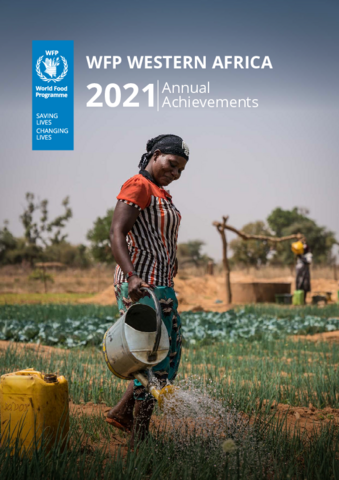
Regional Food Security and Nutrition Context 2021
In 2021, Western Africa faced unprecedented challenges, including protracted conflicts, health emergencies, climatic shocks, and economic problems. The rising number of emergencies coupled with the impact of the COVID-19 pandemic exacerbated the food and nutrition insecurity across the region, with people living in poverty and increasingly fragile environments. Pressures such as inflation eroded household purchasing power, with food prices increasing by more than 20 percent in 2021, leading to reduced food consumption, the sale or consumption of productive assets, and other negative coping strategies, making recovery from shocks more difficult. Furthermore, the region experienced a 1.8 percent decrease in regional cereal production compared to 2020, mainly attributed to pest attacks, poor rainfall conditions, very long dry spells and flash floods.
The security situation in the region has also deteriorated, especially in Burkina Faso, Mali, Niger, Nigeria and Chad. Compared to 2020, there has been a 6 percent increase in violent events, mostly perpetrated by non-state armed groups. Conflict and insecurity led to the forced displacement of nearly 7.3 million people in the region (including 3 million internally displaced persons in Nigeria, 1.5 million in Burkina Faso, 1.2 million in Mali, 1 million in Chad, 565,000 in Niger, and 72,000 in Mauritania), and also resulted in the destruction of livelihoods, the closure of several health centres and schools, and an increased burden on social services in areas hosting large populations of IDPs. Armed group attacks were also recorded in coastal countries such as Côte d'Ivoire, Benin, Togo, attesting to the geographic expansion of insecurity. Humanitarian access to conflict-affected areas remained a significant challenge: the deterioration of the food and nutrition security was particularly marked in areas with limited or no humanitarian access.
The impact of the COVID-19 pandemic was also evident in 2021. Countries across the region experienced a continued decline in monetary exchanges, the closure of the borders, loss of income-generating activities, disruption to crossborder trade, as well as the rise in international commodity prices and freight costs.
The nutritional situation deteriorated sharply in Western Africa, especially in the Central Sahel and the Liptako-Gourma triborder area. This is a consequence mainly attributed to the deterioration of the security situation, the closure of health centers and the interruption of nutritional care and essential health services. The prevalence of acute malnutrition reached emergency levels in several countries, particularly in Mali, Niger and Nigeria. Alarmingly, two thirds of the areas analysed have a prevalence of global acute malnutrition (GAM) above the critical threshold of 10 percent and the rate of severe acute malnutrition (SAM) exceeds the alert threshold of 2 percent in most countries.
In 2021, 31 million people were in acute food insecurity (crisis phase or worse) during the June-August lean season in Western Africa . WFP maintained the same level of assistance as the previous year, reaching 18.3 million beneficiaries – which represents a 72 percent increase compared to 2019. Across the region, WFP continued to provide assistance through various interventions such as emergency food assistance to IDPs and host families, refugees, returnees and lean season-affected people; school feeding, including emergency school feeding; treatment and prevention of malnutrition; resilience building through food assistance for assets and complementary support, agricultural market support for smallholder farmers; and national capacity strengthening.
Besides in-kind food assistance, WFP increased the use of cash-based transfers (CBT) where conditions allowed. Notably, the use of CBT was significantly scaled up in the region over the past years, with a 70 percent increase between 2019 and 2020; along with a further 10 percent increase in 2021, where around USD 260 million was provided to beneficiaries. In 2021, the CBT modality represented 32 percent of WFP assistance in Western Africa, helping to minimize logistical and supply chain challenges, while also stimulating local markets.
See also:-
WFP West Africa Annual Achievements 2020
RBD Year in Review Booklet 2021 - Annual Results Infographic
